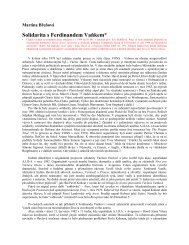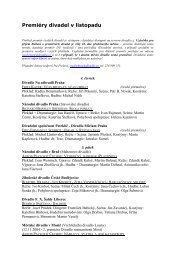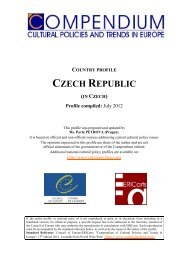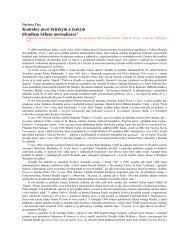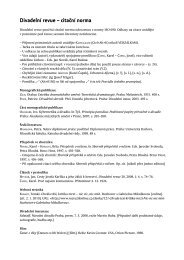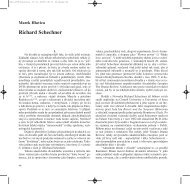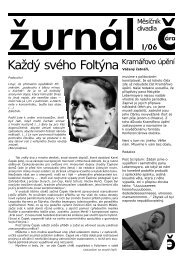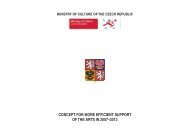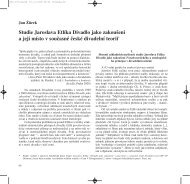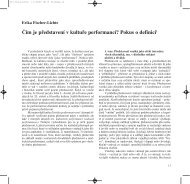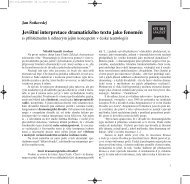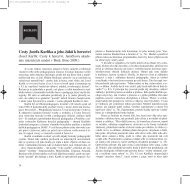METAPHOR AND IRONY 2 - Divadlo.cz
METAPHOR AND IRONY 2 - Divadlo.cz
METAPHOR AND IRONY 2 - Divadlo.cz
Create successful ePaper yourself
Turn your PDF publications into a flip-book with our unique Google optimized e-Paper software.
However, the author of the scenic element is not the stage technician, but the<br />
actor himself. The action of the performer has as its result the movement of the<br />
scene - its change. This change is not only an indication of a change in place<br />
but also relates to the meaning, and even has an emotional impact. The manipulation<br />
of an object (part of the set) thus creates a stage metaphor, and the<br />
“atmosphere” of a particular situation. Most suitable for action scenography are<br />
simple, easily manipulated objects (rope, boxes, drapery), but could include the<br />
“more difficult” dustbin or barrel. Suspended ropes could be a forest; knotted<br />
together, the trunk of a single tree, a net or a gallows (Jan Dušek). Drapery could<br />
represent the sails of a ship, a tent, the foliage of a tree or the sky (Jaroslav<br />
Malina). Incessantly living scenery, scenery in movement, scenery in the hands<br />
of the actor was open to chance and improvisation.<br />
Otherwise “ordinary” materials, discovered on rubbish heaps or in junk<br />
shops, were used as much for their practical qualities as for their capacity to<br />
support aesthetic rationales and period feel. Decoration was foreign to the<br />
designers of this generation; they were attracted towards the exploration of the<br />
qualities of various materials and their direct effect. That connected them with<br />
the influences of European experimental theatres of the time and the visual arts<br />
generally (the anti-decorative and at the same time visual and emotional “poor<br />
theatre”, “aesthetic ugliness”, finding aesthetic qualities in corrosion, in<br />
destroyed and thrown-out objects and so on). However, Czech artists for the<br />
most part adapted accepted “trends” to their own needs. They lightened the<br />
rawness and commented with humor (their playfulness was inherited from the<br />
interwar avant-garde which understood the stage as a space for provocatively<br />
triggered play), they upset austerity and asceticism (often ironically) by use of<br />
decorative details. Under a totalitarian regime, “metaphor and irony” became<br />
weapons and, by a conspiratorial method, a means of communication with an<br />
audience which came to the theatre to taste at least the atmosphere of freedom.<br />
Further tendencies of this trend were sought through the use of nontraditional<br />
space. If designers were working in a traditional proscenium arch<br />
theatre they tried to take the play into spaces other than the stage itself (the<br />
foyer, the front of the theatre, etc.) or to furnish the auditorium with atypical<br />
scenic elements (drapery over-arching the stage, trunks of trees in both the<br />
stage and the auditorium, etc.).<br />
Costume, stylised expressively and daringly, was an important element<br />
of the production. Its metaphorical communicability was underpinned by<br />
quotation and often heterogeneous to the point of an absurd combination of<br />
various historical elements and costume styles. This occurred almost 20 years<br />
before the impact of Post-Modernism was felt in Bohemia. The concept and<br />
appearance of the set and costumes were closely connected (whether in the<br />
sense of stylistic unity or contrast). It was not unusual for the set and costumes<br />
to be designed by the same designer, a link to the past practices of Vlastislav<br />
Hofman.<br />
18



